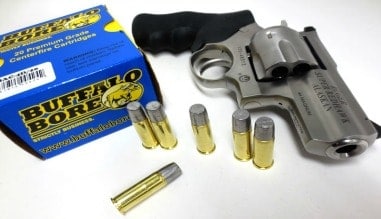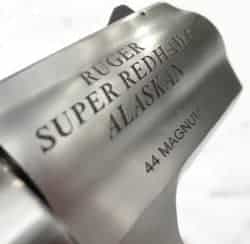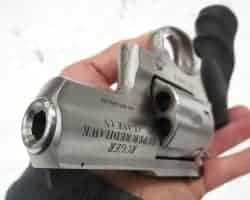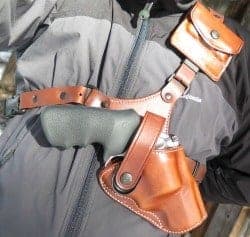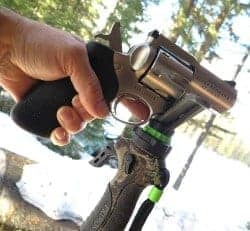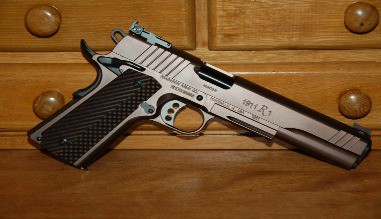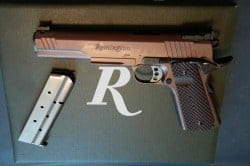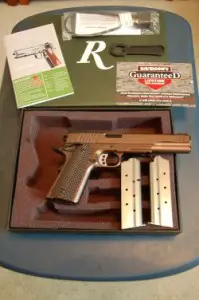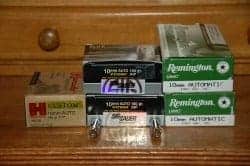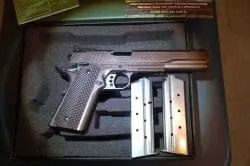
I have been very fortunate to not only travel the world teaching some of the most capable operators from elite units, but to also learn a great deal from them. Mental fortitude is mandatory to be able to function like an elite operator. But what I have also come to find out is that… What seems to separate the elite from the rest is their refined movement.
-This was originally published on Gun Carrier and has been shared with permission-
A lot of gun owners are under the false sense of security that they can just show up to the firing range, fire off a couple of hundred rounds, kill the paper targets in front of them, and head home. Once they get home, they sit on the couch and post their range pictures to Facebook. While commenting on these posts they brag about how they are ready for the next Zombie Apocalypse, or any intruder who may break into their home.
Don’t get me wrong… practicing your marksmanship at the range is a must in order to develop sight alignment, sight picture and a good grouping of those expended cartridges. But it’s only part of the equation needed to fully be prepared during a self defense scenario with your firearm.
When I teach basic NRA courses to the general public, I always ask the participants, at the start of the course: “Why are you here?”
The answers vary but they usually lead to the same final response…. Self Defense!
I tell them that they are starting at the right place. However, the keyword here is “starting”! Just like any new skill that we want to learn, there is always a beginner’s stage. I explain that we need to learn the alphabet of firearms training and safety. We then move on to forming words after we understand the alphabet. Eventually, they will progress to completing full sentences and telling stories with their firearm training.
That pretty much sums up the process for learning most skills.
So as you can tell, there is an educational process to not only learn but to also progress with your firearms skills. Within our NRA basic courses, we “master” the alphabet and possibly a few words. But that is basically it. In this case the alphabet conveys the simple principles of safety and marksmanship. But if you hope to bode well during a self defense application… you need to progress through all the stages; eventually telling stories with your firearms.
As I stated earlier, movement and biomechanics is what separates the extremely capable from the rest. Just like any of these elite operators can confirm, you need to put in countless hours of training. This will enable you to tie your firearms to your natural movement. Your firearms will become an extension of your body as opposed to just being another tool in your hands.
Maneuver Like An Elite Operator
I would like to share with you 5 tips that I learned from these elite military and law enforcement professionals around the globe. Even if you don’t think that you can operate at the same level as these Hard-Chargers, you can still improve your battle readiness with the following tips.
So let’s delve into what makes these individuals operate at a level that is usually reserved for Hollywood’s blockbuster movie actors.
1. Fitness Level:
Your fitness level has to be addressed if you wish to be successful in any self defense scenario. When we add in firearms, your fitness becomes even more crucial.
Let’s face it… If SHTF during a home invasion, our limbic system kicks in. Our heart begins to pound, our breathing becomes heavy and exaggerated and our hands begin to sweat. If your cardio and strength levels are not up to par, you may end up taking yourself out of the conflict right from the beginning, and become useless for both yourself and your loved ones.

Regular exercise has to become part of your weekly routine. I hear from my clients that they really do not have time to incorporate fitness training into their personal practice. I respond with, “Well then… are you willing to die because you couldn’t find a few hours per week to exercise?” Keep in mind that these clients choose to be armed. With that #2A Right and choice comes great responsibility!
Now, this may sound harsh to you, but we are talking about some serious situations here. These scenarios are no joke! We are taking on the responsibility to protect ourselves as well as our families. Just access the “real news” on various sites and you will see and hear about these types of situations happening in the real world everyday.
These operators, who we want to move like, invest many hours into their fitness training. Understandably, they train smart with excellent protocols that save them lots of time while achieving the biggest gains in their tactical fitness. As you can imagine, these elite first responders have jam-packed schedules. But they still find the time to get their exercise routine in. Trust me… They do this because they want to come out on top during a battle, NOT because they want to lose weight or get 6-pack abs. But hey… Who doesn’t want abs as long as it’s a byproduct of efficient training? 
2. Joint Mobility:
Joint mobility has been gaining in popularity in recent years. I was first introduced to various joint mobility exercises and routines while training and learning Russian Martial Arts. I would see my teacher’s flow in ways that impressed and inspired me. I also became aware that if we are able to use our joints and ligaments to perform work, as opposed to using type II muscle fiber, we will waste much less energy. This enables us to fight longer and recover much faster.
I quickly realized that we are as healthy as our joints. Once our joints begin to stiffen up, that’s when we become “old.” Have you ever seen an 80 year old grand master martial artist walk? They seem to glide across the floor as they walk up to their opponent. Well, they mastered the movement and maintenance of his or her joint mobility.

As we get older, we lose muscle tone and other youthful treasures. However, if you can maintain your joint health, you will remain battle-ready for whatever comes your way. Remember that same grand master that we brought up earlier? How do you think that at his age he is still able to wipe the floor with a 20-something year old student whom is much bigger, stronger and younger?
Move your joints and connective tissue in various planes of motion on a daily basis. Some of these routines may seem like something out of a Michael Jackson video but there is a reason why these elite operators perform these movements on a daily basis.
The Health of Your Joints & Connective Tissue Directly Affect How Your Body Ages.
3. Spinal Alignment:
Maintaining a long spine, from your tailbone to the crown of your head, is a must when practicing proper biomechanics. When I am teaching spinal alignment, I explain how we need to have our “antennas” up when we are performing any type of movement. As with all of the tips that I am conveying in this article, when we get into a battle, proper spinal alignment becomes a must.
As we walk around with our firearms at the ready, during a possible self defense conflict, we need to walk tall. Not only will this give you better vision as we check and clear each room, but it will also increase your reaction time. If we round or arch or backs we are collapsing our lungs, making it more difficult to breathe. As I mentioned earlier, our nervous system will already be kicked into overdrive. It will be tough enough to breathe just by being involved in that scenario; We want to avoid any extra problems from our lungs being collapsed.

When we fail to maintain a long spine, we tend to place our bodyweight on our toes and/or heels. This gives the “bad guy” a huge advantage, because they will be able to break your structure, since you are already halfway there with your poor spinal alignment. Preventing your attacker from grabbing your rifle or shotgun barrel and being able to gain the upper hand by affecting your balance are all valid reasons to maintain your spinal alignment. Proper alignment will also go a long way in improving your marksmanship.
4. Breathing:
When I begin addressing breathing during training courses I always get a puzzled look. Then I usually receive the wise-ass comment; “I’m excellent at breathing… I do it all the time!” of course, under duress things can change.
When we are in a combative situation, we tend to hold our breath. By holding our breath we restrict our movement. Let’s not forget that we are adding to the stress of the current situation by not exhaling. As we go over in the “alphabet” of marksmanship… We need to breathe normally if we expect to hit our target regularly and with a good grouping. We go over this fact as we are killing paper. But what do you think happens when we add in the uncertainties of a combative situation?

Our heart rate will be much higher during a battle situation, wherever it may be. By holding our breath we retain more carbon dioxide. This causes our heart to beat even faster. We need to exhale and exhale forcefully to get rid of the excess tension and lower our heart rate. By doing this you will recover much quicker in an actual self defense situation.
As the saying goes… He who recovers quickest, usually wins!
5. Midfoot Drive:
Placing your bodyweight in a midfoot position means that with each step that you take, your weight is between the balls of your feet and your heel; hence the midfoot drive. This offers many advantages regardless of the terrain that you are operating in. Let’s forget about a battlefield situation and just focus on what we may encounter in our homes while trying to address someone wanting to cause harm to our family.
You may have pets and children in your home. This usually adds to extra toys and trinkets lying around and scattered across your floor. Now, add in the fact that the bad guy may have broken some of your goods, which are now on your floor along with the toys. There may be liquid spilled on your floor or even the possibility of blood. If you were to walk around, regardless of the footwear that you have on, these items may now become obstacles. These obstacles can easily take you out of the fight.

When you take a step and land on your midfoot, you will be able to control the placement of your step and body weight with greater awareness. If you land on your heels or toes and you encounter some of these obstacles, you can easily twist an ankle, alert your enemy of your position, slip or any other scenario that greatly decreses your chances of boding well in this encounter.
The same way that we develop our sensitivity with our hands and fingers is similar to the way that we need to address our feet and toes. We have to “feel” what our foot position is telling us via neuromuscular feedback. Once we are in tune with each step that we take, we will develop proprioception enabling us to almost, pre-react, giving us a leg up on our enemy. That one principle alone is what separates many of the elite from just another guy with a gun.
Bottom Line:
I shared with you 5 tips that will get you closer to moving like one of the elite. As you may realize, there is much more that goes into conducting yourself in the same fashion as these badasses. The mental aspect alone is a whole other subject that makes them who they are. But if you can tie these 5 tips together, not only will you fare better in an emergency but you will also remain much safer and healthier as you progress through life.
It’s A Win-Win Situation For You!
If you want to be able to defend yourself and your loved ones with much more effectiveness and accuracy, put some, hopefully all, of these tips into action. It won’t happen overnight but I can promise you that if you train correctly, you will find yourself improving with each passing day.
Up Next: Beginner’s Guide To Having an Outdoor Herb Garden | Survival Gardening
What do you think of our post on learning to maneuver like an elite operator? Let us know in the comment section below.

If you’re looking for useful survival gear that you can’t make at home, check out the Survival Life Store!
from SurvivalLife https://survivallife.com/5-tactical-tips-maneuver-elite-operator/









